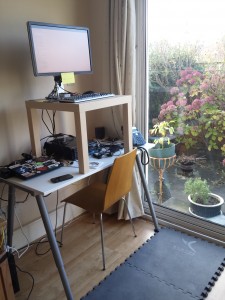So my corporate laptop for the last three years has been a Thinkpad x220, it’s getting a bit long in the teeth, when I got it the x230 was already out but the corporate standard hadn’t rebased. This time I happened to get a new device just after the new corporate refresh so I have the shiny X1 Carbon gen 3 with real track pad buttons.
Of course I grabbed the latest rawhide nightly boot.iso to install the latest shiny! How did I get on? Initially it was disaster, the kernel crashed before I even got to anaconda (will spend some time to recreate and log that soon). Oops! So I grabbed a couple of the earlier installers and with a bit of trial and error before long I was at the initial anaconda screen. From there the process was relatively boring! Up and running with Fedora Workstation installed, disk encrypted I started to play with it to see which bits were good, bad or ugly.
So first up with the good. Over all the vast majority of the hardware just worked out of the box. The GPU, USB3, wired ethernet, wireless ethernet (iwl 7265 AC), trackpad/thumb pointer, bluetooth mouse, camera, onboard speakers all work just fine, I even managed to enrol my finger in the finger print reader without issue. I must say I’m loving the 1920*1080 screen over the old 1366*768 of the x220 and I’m getting use to the chiclet keyboard layout. Overall F-23/rawhide is solid right out of the gate with pretty much everything working as you’d expect on a stable release. 🙂
It’s not all rosy though and some of the bad is that I’ve not managed to get the firmware upgraded to support 4K displays @ 60hz, thanks to Major and Sandro for the heads up on this, but it never seems to find the usb stick as a bootable image. Not a major issue in the short term as the OneLink Pro Dock I ordered is AWOL but I’ll want it soon as I’ve got a standing desk with a Dell 24 inch 4K monitor. The x220 and 4K monitor had never really worked overly well, the big issue was it only ran at 30hz refresh but I knew that when I got the monitor because I knew I was due for a refresh soon, it also had random glitches. I also need to workout how to adjust the acceleration of the thumb pointer thingy with libinput. Adjusting either the trackpad or mouse options in control panel doesn’t seem to have any effect, I never really used the trackpad on the x220 but I admit I’m getting use to the two finger scrolling for reading long pages. This should all be relatively easy to solve with a bit of poking!
The ugly seems to be the stability of the iwl 7265 wireless driver/firmware. It generally works but regularly shits itself. Some times minor by dropping SSH connections, sometimes majorly resulting in a need to unload/reload the modules or even to reboot! URGH! I’ve heard people complain about recent Intel Wireless stability but the “Advanced-N 6205 [Taylor Peak] (rev 34)” that was in the x220 was always solid. The solid lockups seems to be when pushing a reasonable amount of data via rsync/ssh. I do have a WRT1900AC router and I’ve connected to the 5 ghz 11ac so I’m wondering whether this combo is part of the issues. There is a newer firmware that hasn’t made it upstream yet. I need to do some more playing here testing the 11n 2.4ghz network as well as testing the newer firmware and possibly some patches that are on the wireless mailing list which I’m hoping will actually just land in 4.2 before long 🙂
There’s a few other things I need to play with some more. I’ve not tried external HDMI video/audio, the external display port, the DP to VGA converter (nice one was included in the box though) or the headphone/mic socket. None of the functionality of the dock has been tested yet simply because it’s yet to show up! It reports around 7.5 hours of battery life but I want to look at what the state of power consumption on these devices after mjg59’s post about it to see if I can’t get that well into the double digit hours.
Overall I’m pretty impressed with out of box experience of F-23/rawhide on the Thinkpad X1 Carbon gen 3 🙂
